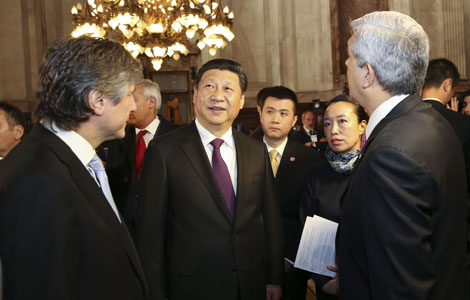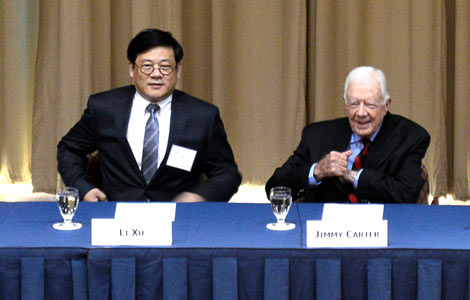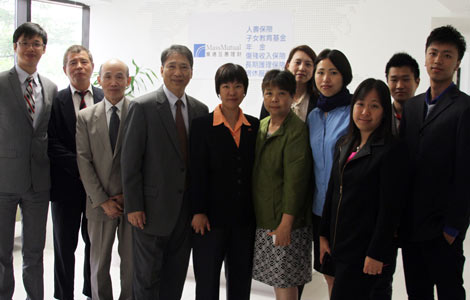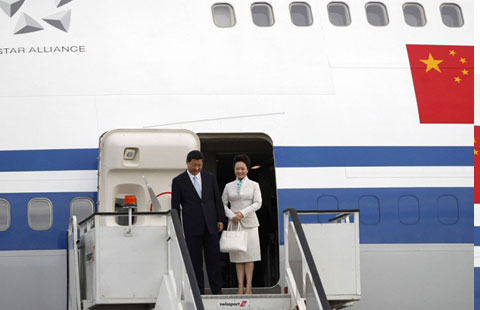Firms going the extra distance as medical tourism blossoms
Updated: 2014-07-21 07:31
By WANG CHAO (China Daily)
|
||||||||
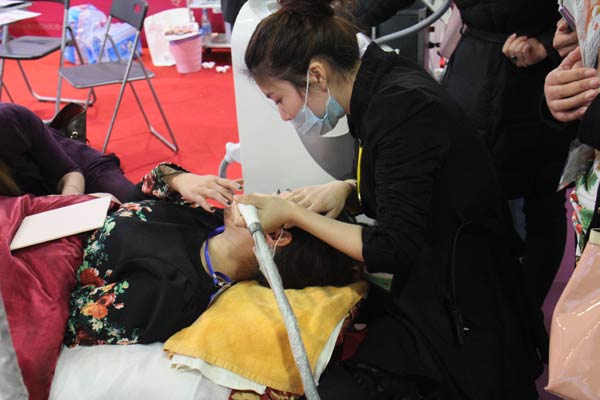 |
|
A customer undergoing skin care treatment at a hairdressing and cosmetics expo in Shanghai. CHINA DAILY |
Europe's aging population has led to the further development of the medical care industry, Li says. In Germany, those 65 or older are more than 10 percent of the population, and people's average spending on medical service is growing by 2 percent every year.
"As society ages, overall consciousness of health is growing," she says. "Good facilities and services attract Chinese upper middle class to get treatment there."
Germany has a mature industry train and a basket of services for overseas tourists seeking medical treatment, Li says.
"In some hospitals, they provide prayer rooms, home country menus and dormitories for the traveling relatives."
European hospitals are also happy to accept wealthy patients, industry sources say. "Hospitals are looking to soften tough economic times and fill beds by extending their market share overseas," says Medical Tourism Magazine, which described an influx of patients to the United Kingdom as a financial windfall.
Eighteen of the UK's National Health Trust foundation trust hospitals reported last year that despite the small numbers of international private patients being treated-7 percent across the sample-these patients were responsible for almost a quarter of total private income in these trusts, according to researchers at the London School of Hygiene and Tropical Medicine and York University.
That represented income of 42 million pounds ($71.9 million) across the 18 hospital trusts during 2010-2011.
"Their report found that medical tourists spent an estimated 219 million pounds on hotels, restaurants, shopping and transport in Great Britain," the magazine says.
The research also showed more Britons going abroad for treatment. Lead author of the research Johanna Hanefeld said that contrary to some popular media reports, the UK is a net exporter of medical tourists. In 2010, an estimated 63,000 UK residents traveled abroad for treatment, while around 52,000 patients came for treatment in the UK, according to the research report.
The level of patients traveling to the UK has remained relatively stable over the last decade, while there has been a substantial increase in the number of UK residents traveling abroad for medical treatment."
Wu Maochun, director of Ciming Oasis Health Management Hospital in Beijing, talks of the huge market potential.
Last year the company received 10,000 patients for advanced checkups, and among them 60 percent came from outside the city. Nearly 100 patients opted to go abroad using its overseas medical tourism services.
Ciming has developed more than 50 partnerships around the world, including in Japan, Switzerland, Singapore, the US and South Korea.
Saint Lucia Consulting, a company opened in Beijing in 2011, previously told China Daily that in the past four years, it has provided Chinese corporate executives, the wealthy and their families with highly personalized medical tourism services, expert translation services and advice on their overseas medical treatments.
CEO Cai Qiang says the company has contracts in the US with Partners HealthCare, the largest network of hospitals affiliated with Harvard Medical School, including Massachusetts General Hospital, Brigham and Women's Hospital, Dana Farber Cancer Institute, McLean Hospital and Spaulding Rehabilitation Hospital.
Liu Yuanli of Peking Union Medical College says there are big differences between medical tourists coming to China and those going overseas.
"Patients in Europe and the US usually choose overseas medical services when the overseas services are much cheaper, and they do this through commercial insurance, while Chinese tourists going aboard are looking for high-end medical services and mostly paying their own bills. They look for treatment for cancer or diseases that are hard to find in China."
But compared with neighboring countries such as South Korea and Thailand, medical tourism in China is still in its infancy.
Part of the reason is the stringent requirements of the Chinese government, says Liu Tingfang, a professor at the Institute for Hospital Management, Tsinghua University.
"Hospitals are required to have less than 10 percent of high-end services so as to ensure the public's medical services," Liu from Tsinghua University says. "Moreover, there are few high-end medical services. We need to allow more private hospitals and foreign hospitals in China so that we can attract more international patients."
Some have already opened. Hainan province has designated Sanya Traditional Chinese Medicine Hospital as a pilot hospital and has been marketing services to Russia, the Middle East and northern Europe. It treats an average of 3,000 overseas patients a year with each patient spending $20,000, hospital head Chen Xiaoyong says. The hospital has treated 30,000 overseas patients.
Recently, Beijing and Shanghai also started such initiatives to expand the medical tourism market.
Liu from Tsinghua University says China needs to build a medical certification system accepted worldwide. "Only by showing certifications can we gain trust from international patients, and it also facilitates the reimbursement process of commercial insurance companies."
Official figures show China has 14,200 hospitals at county level and above, and 1,500 tertiary-level hospitals at the top level. Liu suggests that the government pick some as pilot hospitals to offer more market-oriented medical services. "Otherwise we will miss the opportunities in this niche market," Liu says
Lack of recognition and certification is a big hurdle for TCM in Europe, experts say. Since TCM arrived in Europe, its treatments have been classified as supplements rather than medicine, and they cannot be sold in pharmacies.
- Thai tourism booth hopes to woo Chinese, young and old
- China's tropical island plans medical tourism zone
- Medical sector alive, well and ready to list to fund its future
- Mobile health era coming, challenges ahead
- E-commerce in pharmaceuticals likely to increase, change industry
- Investment, market liberalization to boost China healthcare
Most Viewed
Editor's Picks

|

|

|

|

|

|
Today's Top News
Xi arrives in Venezuela for state visit
Chinese President Xi leaves for Venezuela
Black boxes of MH17 under 'control': rebels
China's Sany ready to act on US govt move
Super typhoon Rammasun batters China, killing 18
China, Argentina seek closer cooperation
President Xi calls for fair investigation into jet crash
China hit by Microsoft cuts
US Weekly

|

|



